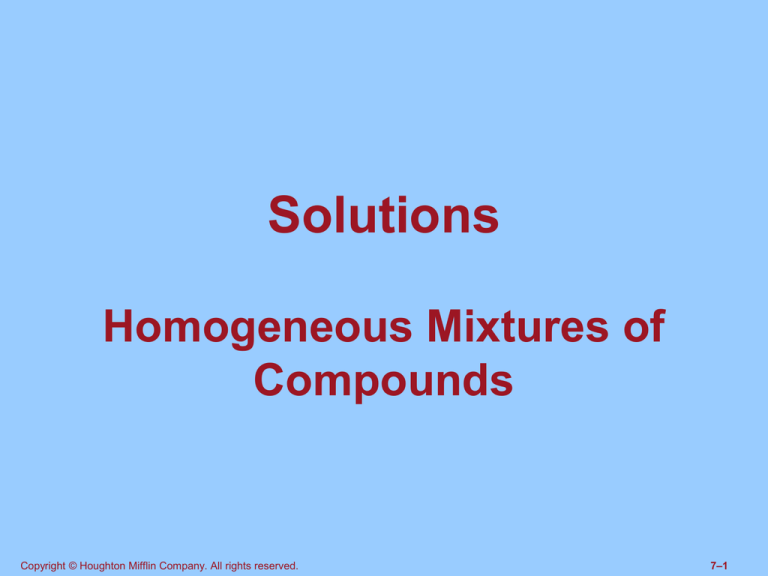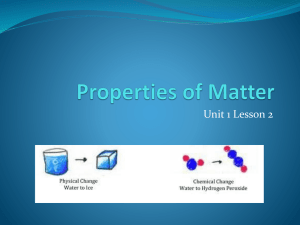
Solutions
Homogeneous Mixtures of
Compounds
Copyright © Houghton Mifflin Company. All rights reserved.
7–1
7.1 Characteristics of Solutions
Definitions:
Solution: A homogeneous combination of
two or more substances, in which each
substance retains its chemical identity
Solvent: The component of a solution
present in the greatest amount
Solute(s): The component(s) of a solution
present in smaller amount(s) than the
solvent
Copyright © Houghton Mifflin Company. All rights reserved.
7–2
7.1 Characteristics of Solutions
Solutions have variable compositions; the
ratio of solvent to solute(s) can be varied.
The properties of the solution change as the
ratio of solvent to solute(s) is varied.
Solutes are present as individual molecules,
atoms, or ions.
The composition of a solution is constant
through space.
Solute(s) can be separated from the solvent
by physical means such as evaporation.
Copyright © Houghton Mifflin Company. All rights reserved.
7–3
7.2 Solubility
Solids and liquids are usually more soluble at high temperatures than at low
temperatures
Gases are usually more soluble at low
temperatures than at high temperatures
Gases are more soluble at high pressures
than at low pressures.
Copyright © Houghton Mifflin Company. All rights reserved.
7–4
Table 7.1 Solubilities of Various Compounds in
Water at 0C, 50C, and 100C.
Copyright © Houghton Mifflin Company. All rights reserved.
7–5
7.2 Solubility
Saturated solutions contain the maximum
amount of solute that the solvent can
hold at a given temperature. Undissolved solute is usually present.
Unsaturated solutions contain less than
the maximum amount of solute that can
be dissolved at a given temperature.
Copyright © Houghton Mifflin Company. All rights reserved.
7–6
Figure 7.3
In a saturated solution, the dissolved solute is in a dynamic equilibrium with the
undissolved solute.
Copyright © Houghton Mifflin Company. All rights reserved.
7–7
7.2 Solubility
Aqueous solutions have water as the
solvent.
Nonaqueous solutions have substances
other than water as the solvent.
Copyright © Houghton Mifflin Company. All rights reserved.
7–8
7.3 Solution Formation
To form a solution, two sets of
intermolecular forces must be overcome
Forces between solvent molecules
Forces between solute molecules or ions
Attractive forces between solute and
solvent particles must compensate for
disrupting the other forces.
Copyright © Houghton Mifflin Company. All rights reserved.
7–9
Figure 7.5
Hydration of ions in an aqueous solution
Copyright © Houghton Mifflin Company. All rights reserved.
7–10
7.4 Solubility Rules
Like dissolves like
In water, ionic compounds are more likely
to be soluble if the charge on individual
ions is low
NaCl (Na1+ + Cl1–) is soluble
Na3PO4 (3 Na1+ + PO43–) is soluble
Ca3(PO4 )2 (3 Ca2+ + 2 PO43–) is not soluble
Ca10(PO4)6(OH)2 is not soluble
Copyright © Houghton Mifflin Company. All rights reserved.
7–11
Table 7.2
Solubility Guidelines for Ionic Compounds
in Water.
Copyright © Houghton Mifflin Company. All rights reserved.
7–12
7.5 Solution Concentration Units
Concentration: Amount of solute in a
specified amount of solution
Percent concentrations
Percent by mass (m/m)
Percent by volume (v/v)
Mass-volume percent (m/v)
Molarity: Moles Solute per Liter Solution
Copyright © Houghton Mifflin Company. All rights reserved.
7–13
7.5 Solution Concentration Units
Molarity:
Moles solute = mol = M
Liter solution
L
Molarity is a conversion factor, like molar mass,
that allows us to convert between moles and
an easily measurable quantity, volume.
Copyright © Houghton Mifflin Company. All rights reserved.
7–14
7.5 Solution Concentration Units
What is the molarity of a solution of NaCl if
50.0 g of NaCl is dissolved in 1.00 L of
water?
How many moles of NaCl are present in
250 mL of 0.100 M solution?
How many milliliters of 0.250 M NaCl will
contain 0.500 mol of NaCl?
Copyright © Houghton Mifflin Company. All rights reserved.
7–15
7.5 Solution Concentration Units
H3PO4 + 3 NaOH Na3PO4 + 3 H2O
How many milliliters of 0.0500 M NaOH will
react with 15.0 mL of 0.0300 M H3PO4?
What is the molarity of H3PO4 if 15.05 mL of
0.1500 M NaOH react with 10.00 mL of
the H3PO4 solution?
Copyright © Houghton Mifflin Company. All rights reserved.
7–16
7.5 Solution Concentration Units
Percent by Mass: %(m/m), %(w/w)
Mass of solute x 100%
Mass of solution
What is the percent by mass of a solution
made by combining 8.5 g of sucrose with
73.8 g of water?
How many grams of sucrose and how many
grams of water must be used to prepare
250 g of solution that is 5.0%(m/m)?
Copyright © Houghton Mifflin Company. All rights reserved.
7–17
7.5 Solution Concentration Units
Percent by Volume: %(v/v)
Volume of solute x 100%
Volume of solution
What is the percent by volume of a solution
in which 15 mL of glacial acetic acid is
diluted to 100 mL with water?
Could you do this by combining 15 mL of
acetic acid and 85 mL of water?
Copyright © Houghton Mifflin Company. All rights reserved.
7–18
Figure 7.7 When volumes of two different liquids are
combined, the volumes are not additive.
Copyright © Houghton Mifflin Company. All rights reserved.
7–19
Figure 7.8 Volumetric flasks are filled to the 50.0 mL
mark with ethanol and with water. The
liquids are combined in a 100 mL volumetric flask, and the volume is 96.5 mL.
Copyright © Houghton Mifflin Company. All rights reserved.
7–20
7.5 Solution Concentration Units
Mass-volume percent: %(m/v)
Grams of solute x 100%
Milliliters of solution
mg/dL
Milligrams of solute
Deciliters of solution
1 mg = 0.001 g
Copyright © Houghton Mifflin Company. All rights reserved.
1 dL = 100 mL
7–21
7.6 Dilution Calculations
It is common to make dilute solutions from
concentrated solutions (a.k.a. stock
solutions)
C1V1 = C2V2
A nurse must prepare 100 mL of 1.0 %
(m/v) AgNO3. She has a 3.0% (m/v)
stock solution. How much stock
solution should she use? How should
she prepare the solution?
Copyright © Houghton Mifflin Company. All rights reserved.
7–22
7.7 Colligative Properties
of Solutions
Colligative properties of a solution depend
on the concentration of solute particles,
not their chemical identity
Lowering of vapor pressure
Freezing point depression
Boiling point elevation
Osmotic Pressure
Copyright © Houghton Mifflin Company. All rights reserved.
7–23
Figure 7.10 Close-ups of the surface of a solvent
(a) pure liquid
(b) with nonvolatile solute
Copyright © Houghton Mifflin Company. All rights reserved.
7–24
7.7 Colligative Properties
of Solutions
Nonvolatile solutes:
Lower the vapor pressure of the solution
relative to that of the pure solvent
Raise the boiling point of the solution
relative to that of the pure solvent
Lower the freezing point of the solution
relative to that of the pure solvent.
Copyright © Houghton Mifflin Company. All rights reserved.
7–25
7.8 Osmosis and
Osmotic Pressure
Osmosis is the passage of solvent
through a semipermeable membrane
from a dilute solution or pure liquid to a
concentrated solution.
Semipermeable membranes have very
small pores, and allow only certain
small molec-ules to pass from one side
to the other.
Copyright © Houghton Mifflin Company. All rights reserved.
7–26
Figure 7.12 (a) Osmosis, the flow of solvent through
a semipermeable membrane from a
dilute to a concentrated solution
(b) At equilibrium, the molecules move
back and forth at equal rates.
Copyright © Houghton Mifflin Company. All rights reserved.
7–27
Figure 7.13 A semipermeable membrane separating
(a) pure water and solute-water solution
(b) dilute solute-water solution and a
concentrated solute-water solution.
Copyright © Houghton Mifflin Company. All rights reserved.
7–28
Figure 7.14
Osmotic pressure is the
amount of pressure
needed to prevent the
solution in the tube from
rising as a result of the
process of osmosis.
Copyright © Houghton Mifflin Company. All rights reserved.
7–29
Isotonic, Hypertonic, and Hypotonic Solutions
Isotonic solutions have the same osmotic
pressure as intracellular fluids
Red blood cells are stable
Hypertonic solutions have higher osmotic
pressure that intracellular fluids
Red blood cells undergo crenation
Hypotonic solutions have lower osmotic
pressure than intracellular fluids
Red blood cells undergo hemolysis
Copyright © Houghton Mifflin Company. All rights reserved.
7–30
Isotonic, Hypertonic, and Hypotonic Solutions
Copyright © Houghton Mifflin Company. All rights reserved.
7–31
7.9 Dialysis
Dialysis is the process in which a semipermeable membrane permits the
passage of solvent and small solute
particles (ions and molecules) but
blocks the passage of large molecules.
Cell membranes permit dialysis
Copyright © Houghton Mifflin Company. All rights reserved.
7–32
Figure 7.17 In dialysis, there is a net movement of
ions from a region of higher concentration to a region of lower concentration.
(a) Before dialysis. (b) After dialysis.
Copyright © Houghton Mifflin Company. All rights reserved.
7–33
Figure 7.18 Impurities (ions) can be removed from a
solution by using a dialysis procedure.
Copyright © Houghton Mifflin Company. All rights reserved.
7–34







